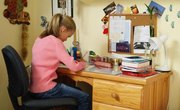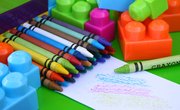Over the course of the school year, your preschool students are sure to amass what seems like a mountain of drawings, paintings, attempts at writing and other similar content-related items. Instead of sending everything home, you can hold on to a few primary pieces per student to create an assessment portfolio for each child. Portfolios at the preschool level provide key insight into each child's development and growth, according to the National Association for the Education of Young Children.
Definite Documentation
If looking back over a year's worth of anecdotal notes makes you feel like you're missing something or you're left wondering what something such as, "Talked red circle group time project" meant, a portfolio provides a more concrete way to document each child's progress. Not only can you keep the actual projects that the children make for the duration of the school year, but you can also clip your records or notes of what they say about their work to the physical object to help you remember what your notes refer to. Doing this provides you with the definite documentation that you need to truly assess the students' progress, and keeping the products of the activities allows you to more easily reflect back what they've learned days, weeks or months after the activity is over.
Progression Portfolios
A portfolio provides you with the opportunity to see the progression of the students' work throughout the course of the entire school year in a concrete way. For example, if you save letter printing samples from August through the following June, you can see how your students went from scribbles and squiggles to writing real-looking letters. Notes that you attach to each portfolio work can also provide a picture of the progression of other developmental skills, such as a child's growing ability to share art materials as she goes from a newly-turned 4-year-old to an almost kindergartner.
Personalized Portfolios
In her article on portfolio-based assessment in Earlychildhood News, Priscilla D. Huffman, a professor of Early Childhood Education at the University of Wisconsin-Stout, notes that preschool portfolios can take away the sense of competition that may arise between children when it comes to the strength or quality of their work and progression. Instead of comparing one student's work against another child's, a portfolio allows you to assess each individual on their own merits. For example, instead of looking at Janey's drawing next to Johnny's -- and noting that one is more clear or looks more realistic than the other -- you can see how Janey went from scribbling to drawing tadpole-like people during the course of the year.
Family Connections
Portfolios in the preschool classroom aren't just for teachers to use. These documentation-assessment systems also provide keen insight into the child's school life for parents and other family members. While the parents may see some of the work that comes home, a portfolio that includes samples of the student's work along with notes, photographs or audio recordings can give parents a full picture of the child's scholastic strengths and areas for improvement. Sending the portfolio home at the end of the school year also provides the parents with a tangible memory of the preschool period that they can look back on at any time.
Related Articles
References
Writer Bio
Based in Pittsburgh, Erica Loop has been writing education, child development and parenting articles since 2009. Her articles have appeared in "Pittsburgh Parent Magazine" and the website PBS Parents. She has a Master of Science in applied developmental psychology from the University of Pittsburgh's School of Education.











